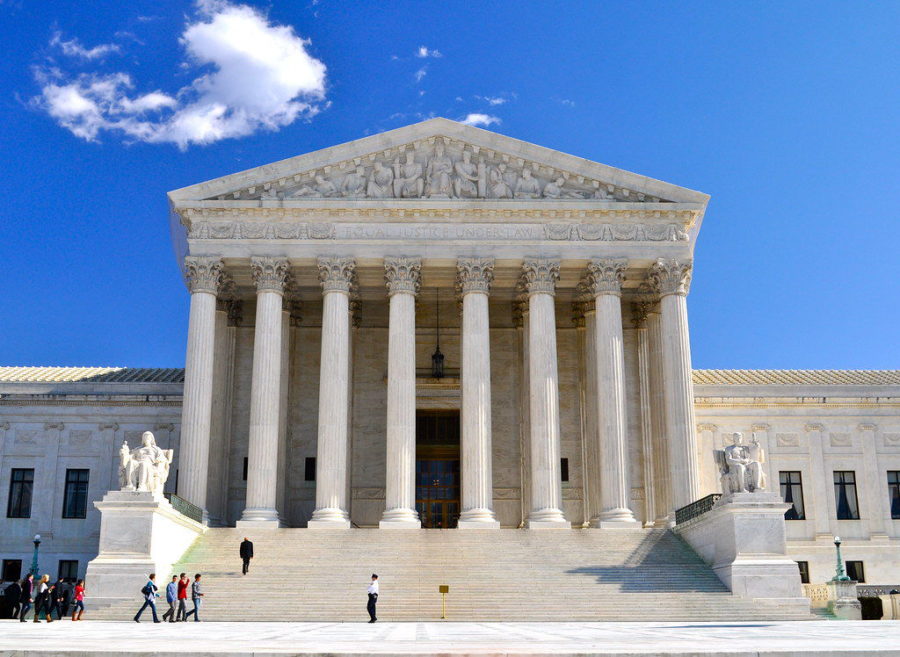As the Supreme Court dynamic changes, abortions and gay marriage laws could, too
October 27, 2020
With Amy Coney Barrett’s recent confirmation to the Supreme Court, many are wondering what this means for court cases like Roe v. Wade and Obergefell v. Hodges.
Barrett’s confirmation gives the Republican party a 6-3 majority in the Supreme Court.
Republican party leaders and members have been looking to overturn Supreme Court cases such as Roe v. Wade and Obergefell v. Hodges, but the legal process to overturn these cases is lengthy.
These court cases have been debated for years but have never been brought back to the Supreme Court.
In 1973, the Supreme Court case Roe v. Wade decided pregnant women have the liberty to have an abortion without excessive government restrictions. In 2015, the Supreme Court ruled that same-sex couples have a fundamental, constitutional right to marry in the court case Obergefell v. Hodges. Both of these court cases are classified under the 14th Amendment as fundamental rights of equality.
In order for these cases to be overturned, a similar court case needs to be appealed to the Supreme Court or someone must challenge the Supreme Court ruling on the case.
Before Obergefell v. Hodges or Roe v. Wade can go to the Supreme Court, it has to be challenged, said Dirk Deam, teaching professor of political science.
The most common way for a case to reach the Supreme Court is by appeal from a circuit court. A party seeking to appeal a decision of a circuit court can file a petition to the Supreme Court to hear the case.
“Four justices have to agree to hear a case before the Supreme Court takes the case,” said Mack Shelley, professor and chair of the political science department.
The Supreme Court agrees to hear about 100 to 150 cases a year out of more than 7,000 they are asked to review, according to United States Courts.
“There are two ways that the court could rule on a case: majority opinion or plurality opinion,” Deam said.
Majority opinion would mean a 5-4 decision while a plurality opinion is when there is no majority opinion.
The question of Roe v. Wade and Obergefell v. Hodges’ fates were brought to the stage after Barrett’s hearings.
Shortly after Barrett was nominated, Justice Clarence Thomas and Justice Samuel Alito spoke out on the decision of Obergefell v. Hodges. They wrote that the ruling “enables courts and governments to brand religious adherents who believe that marriage is between one man and one woman as bigots, making their religious liberty concerns that much easier to dismiss.”
The justices spoke out just two days after the court declined to hear an appeal case of Kim Davis. Davis is a clerk in Kentucky who was sued by several couples for refusing to issue marriage licenses to same-sex couples after it was legal.
Chief Justice John Roberts, who dissented in the 2015 decision along with Thomas and Alito, did not sign on to the Thomas-Alito statement to the case. Justice Neil Gorsuch and Brett Kavanaugh, who were appointed by President Donald Trump, did not sign on to the statement either.
It is unclear how Gorsuch, Kavanaugh and Barrett would vote on a court case involving same-sex marriage or abortions laws, but they have all been supporters of religious rights.
During Barrett’s hearing, she gave no indication on how she would rule on cases similar to Roe v. Wade and Obergefell v. Hodges.
In a previous interview with NPR, Barrett said, “I don’t think the core case, Roe’s core holding that women have a right to an abortion, I don’t think that would change.”
Trump chose Barrett as his nominee to profile his promise he made four years ago on the debate stage: to only appoint pro-life justices to the Supreme Court.
Barrett, who is a devout Catholic, said during her hearings, “It’s never appropriate for a judge to impose that judge’s personal convictions, whether they derive from faith or anywhere else, on the law.”
Depending on what case is brought to the Supreme Court and how that case is ruled upon, Barrett’s decision would affect how the state responds to gay marriage and abortion laws, Deam said.
Before 2015, 37 states legalized gay marriage. States like Arkansas, Georgia and more had not. Depending on the case, it would be up to state governments to decide if they recognized or legalized gay marriage in that state.
Before Roe v. Wade, abortions were illegal in 30 states; if overturned, it would fall to the states to decide if abortions were legal or not. Nine states, such as Alabama and Arizona, still have their pre-Roe abortion bans, which would be enforced if Roe v. Wade was overturned.
“Cases that are overturned would go back to individual states to decide on, but the case could be appealed to the Supreme Court again,” Shelley said.
If the Supreme Court overturns Roe v. Wade or Obergefell v. Hodges, those rulings can also be overturned — it would just take a while, Shelley said.
A court case like Plessy v. Ferguson was overturned by Brown v. Board of Education, ruling that “separate but equal” is unconstitutional. It was almost 60 years after Plessy v. Ferguson before it was overturned and ruled unconstitutional under the 14th Amendment.
The Supreme Court could hear a case similar to Roe v. Wade or Obergefell v. Hodges that aims to overturn them, but it would be a long process.
Under Roe v. Wade, states have the right to limit and regulate the use of abortion. Iowa and other states have implemented a “heartbeat bill,” making it illegal to have an abortion after a fetal heartbeat is detected.
“It is much harder to get rid of rulings like Roe v. Wade and Obergefell v. Hodges, so it is more likely that the conservative court will chip away at those cases,” Shelley said.







